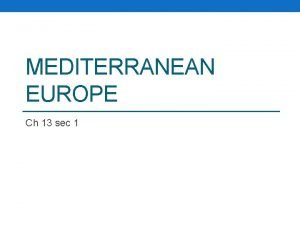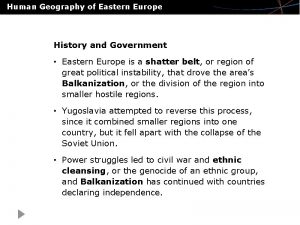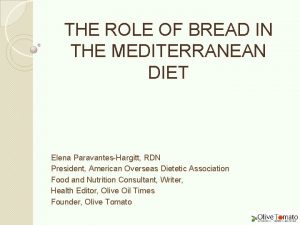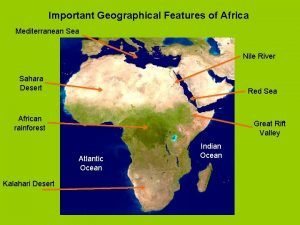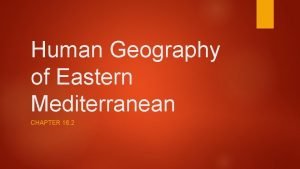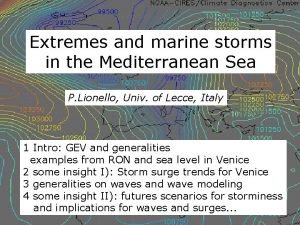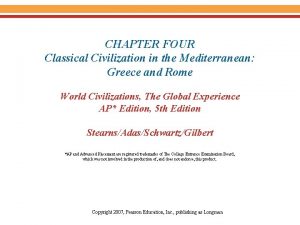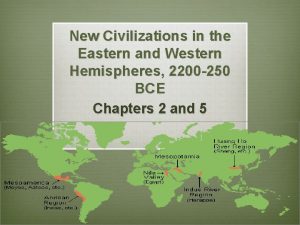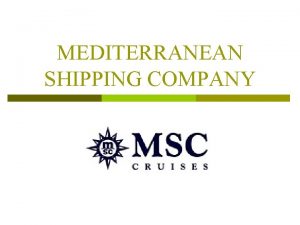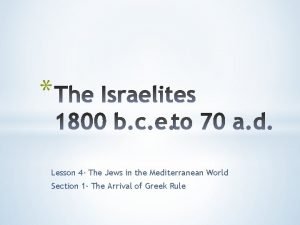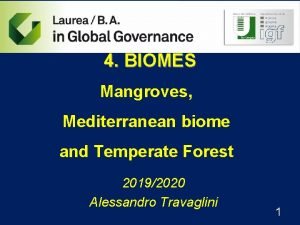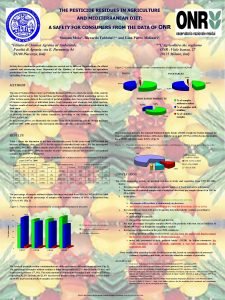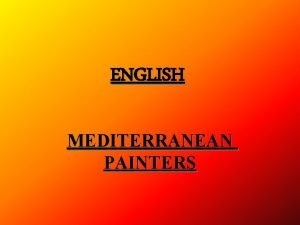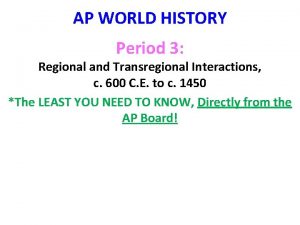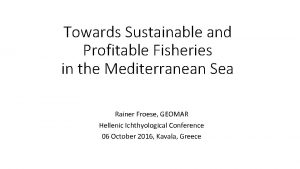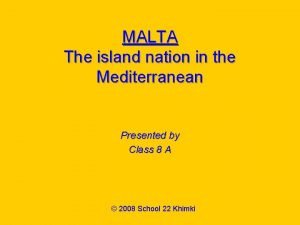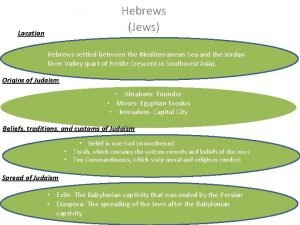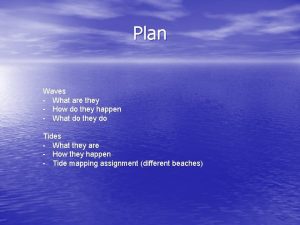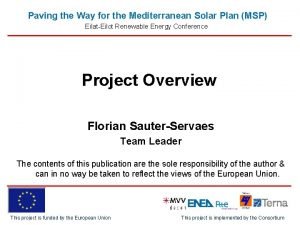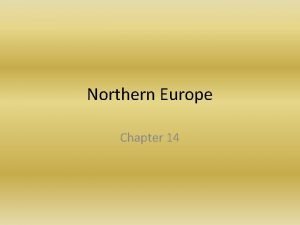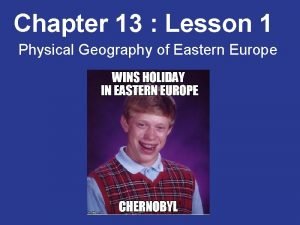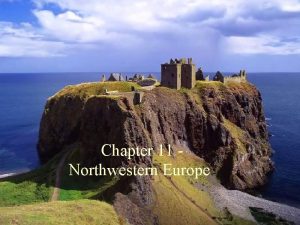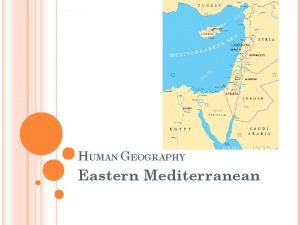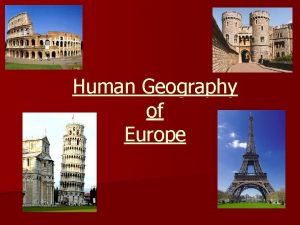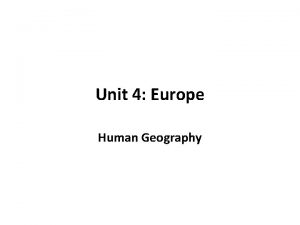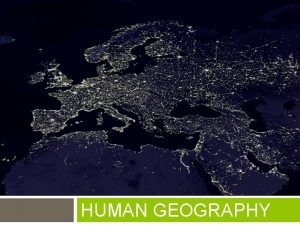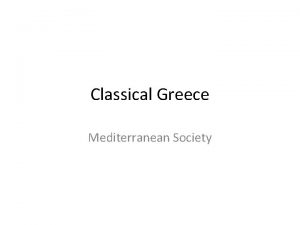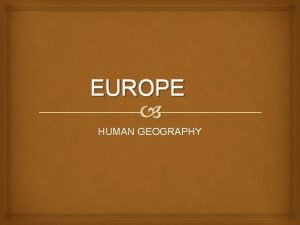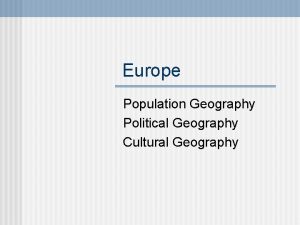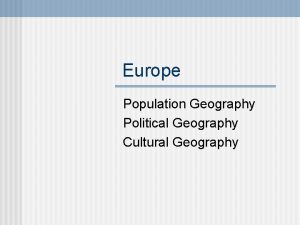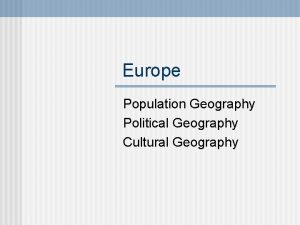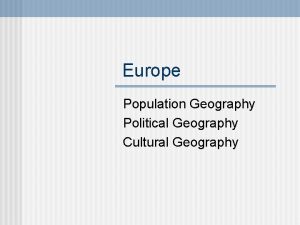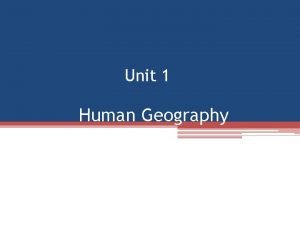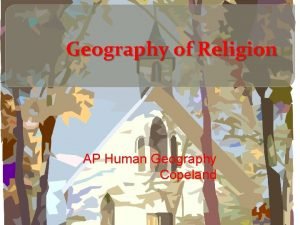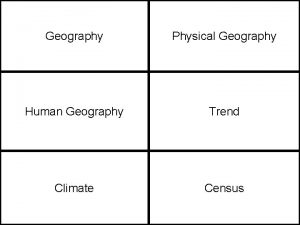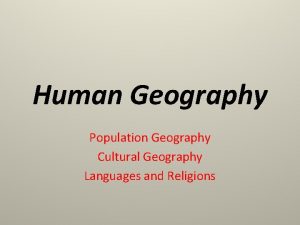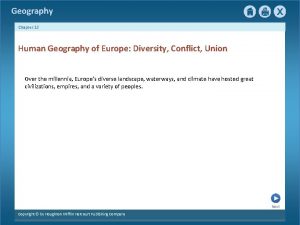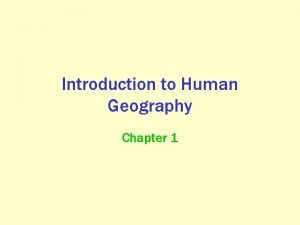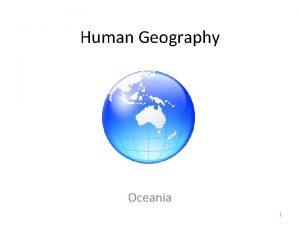Human Geography of Europe Mediterranean Europe n The














































- Slides: 46

Human Geography of Europe

Mediterranean Europe n The Mediterranean region was home to two great civilizations of ancient Europe: – Ancient Greece – Ancient Rome

Mediterranean Europe n Two geographic advantages helped the Mediterranean become the region where European Civilization was born: – The mild climate made survival easier – The Mediterranean Sea allowed for overseas trade

Four Forms of Government in Ancient Greece n Monarchy: – Form of govt. in which the ruling power is in the hands of a single person. – This was the case under the Mycenaean's who ruled Greece from 2000 to 1100 BCE.

Four Forms of Government in Ancient Greece n Oligarchy: – Form of govt. in which the ruling power is in the hands of a few leaders. – Between 1100 and 800 BCE small groups of people began to share the ruling power – This was shared among aristocrats. – People lacked full political rights

Four Forms of Government in Ancient Greece n Tyranny: – Form of govt. in which the ruling power is in the hands of an individual who has seized control, often by illegal means. – Tyrannies in Greece first arose during the mid 600 s BCE. – Many tyrants only ruled for short periods of time.

Four Forms of Government in Ancient Greece n Democracy: – Form of govt. in which the ruling power is in the hands of all the people. – Democracy developed in ancient Greece around 500 BCE in the city-state of Athens, where many people began to oppose the rule of the tyrants. – One important fact: Public officials did not have that much individual power.

The First Democracy n Ancient Greece left a lasting legacy to modern civilization. n The city of Athens developed the first direct democracy.


Math & Science n Pythagoras – Greek mathematician – Developed a formula to calculate the relationship between the sides of a right triangle – Method still in use today – (Don’t like geometry? Blame him!!) n Aristarchus – Greek astronomer – Discovered that the earth rotated on its axis, and revolved around the sun.

Math & Science n Eratosthenes – Discovered that the earth was round – Accurately calculated its circumference n Euclid – Wrote a book called The Elements – It is the basis for modern geometry n Archimedes – Tried to use science for more practical matters – Developed the lever and pulley system that could lift just about any weight.

Medicine n Hippocrates – A 5 th century BCE physician – Studied the causes of illnesses and experimented with various cures – He is also credited with creating a set of ethical standards for doctors called the Hippocratic Oath.

Religion n Polytheistic – Multiple gods – Greeks used myths and gods to explain nature n Mt. Olympus – Home of the gods – Supreme god - Zeus – Greeks held festivals to honor gods § Olympic Games

ANCIENT ROME

The Roman Republic/Empire n In 338 B. C. Ancient Rome came to power. n The territories it controlled became known as the Roman Republic/Empire. n Romans adapted Greece’s democratic government and created the first Republic.

The Roman Republic/Empire n As the Roman Empire grew it gained territories as far away as Southwest Asia in a region known as Palestine – Included Jerusalem § The city where Jesus was born

Rome’s Beginnings n Mythical Version: ~ Trojan prince Aeneas discovers Latins while searching for new homeland ~ The legend of Romulus and Remus explains the creation of Rome

Rome’s Beginnings n Mythical Version: ~ Trojan prince Aeneas discovers Latins while searching for new homeland ~ The legend of Romulus and Remus explains the creation of Rome

Rome’s Beginnings n Historical Version: ~ Latin people settled on the Palestine Hill in Rome ~ Etruscans conquered the Latins; ruled harshly ~ Rome was ruled as a monarchy for over 200 years ~ Romans overthrew the Etruscan kings and established a Republic in 509 BCE (Before Common Era)

Rome’s Beginnings n Historical Version: ~ Latin people settled on the Palenstine Hill in Rome ~ Etruscans conquered the Latins; ruled harshly ~ Rome was ruled as a monarchy for over 200 years ~ Romans overthrew the Etruscan kings and established a Republic in 509 BCE

The Decline of the Republic: Julius Caesar n. Celebrated Roman general and statesman n. Formed a Triumvirate (3 person rule) n. Julius Caesar n. Crassus n. Pompey n. A battle for control results in a civil war n. Caesar won and declared himself “dictator for life” (46 -44 BCE)

The Decline of the Republic: Julius Caesar n Established social reforms n Gave assistance to the poor n Re-distributed land n Established the Julian Calendar - Used through the 17 th century n Expanded the Roman Republic by invading Gaul, Britain, Libya, Egypt, Syria, and Asia Minor

Assassination of Julius Caesar n Many criticized his king-like status n. Cited an ancient law that anyone trying to be king should be killed n A group of Senators plotted to kill Caesar at the Senate building n On March 15, 44 BCE, Caesar was stabbed by multiple Senators

Assassination of Julius Caesar n A second triumvirate was formed n. Octavian n. Mark Antony n. Lepidus n Divided the Roman world into three parts n. Octavian defeated the others and became the sole ruler of Rome n. He was renamed Augustus Caesar n 1 st emperor of Rome

The Rise of Christianity n Judea was a province of n The new faith began Rome as a sect of Judaism – Jews were banned from living in Jerusalem – Jesus went to Jerusalem and began preaching his message – Roman and Jewish leadership saw Jesus as a threat & he was crucified – Based on the belief that the messiah had been resurrected – Became a separate religion as it was spread to the pagan world

The Rise of Christianity n Paul traveled widely to spread the faith – Incorporated old pagan traditions with new Christian traditions – Christians were persecuted by until the 300 s CE n Emperor Constantine converted to Christianity in 312 CE – Issued the Edict of Milan (313 CE) – Emperor Theodosius made Christianity the official religion of the entire empire in 392 CE

Decline of the Empire n Problems in the empire: ~ Political Instability ~ Economic Decline ~ Social Issues ~ Barbarian Invasions Constantine moved the capital to the city of Byzantium n Renamed it Constantinople n

Decline of the Empire n After the death of Theodosius, the eastern part of the Roman Empire became known as the Byzantine Empire n Barbarian invasions by the Visigoths, Huns, and Vandals led to the fall of Rome in the late 400 s CE n Led to a dark age in Europe; lack of a strong central govt.


Medieval Europe Lasted for 1, 000 years between 500 -1500 ACE (after common era) n Known as the “Dark Ages” n – The invaders destroyed all works of art and education stopped – The green revolution took place as well as other technological innovation.

Medieval Europe Between 900 -1400, Feudalism became the political, economic, and social structure of Europe. n Absolute Monarchies and the Roman Catholic Church amassed enormous power. n

The Crusades n The region of Palestine was officially Muslim. – The leaders of the Roman Empire wanted the region to become Christian since it was originally the birth place of Jesus Christ. – In 1096, European Christians launched the Crusades § A series of wars to take Palestine away from the Muslims.

The Crusades This led to the spread of Christianity throughout Europe n Christianity became Rome’s official religion. n

The Renaissance, – Began in Italy – Was a time of renewed interest in learning and the arts that lasted from the 14 th – 16 th centuries. n This period of time was inspired by many Italian classical artists and writers. n Renaissance ideas eventually spread throughout the rest of Europe. n

The Reformation n During the Renaissance, almost all of Europe was under the law of the Catholic Church. n At this time, the Catholic Church was very corrupt and scholars began questioning its authority. n There were four types of causes to the reformation: – Social - Economic – Political - Religious

The Reformation n During the Renaissance, almost all of Europe was under the law of the Catholic Church. n At this time, the Catholic Church was very corrupt and scholars began questioning its authority.

The Reformation n Martin Luther – Published 95 statements that criticized church practices that he believed were wrong. – This began the Reformation § A period of time when many Christians broke away from the Catholic Church and started Protestant churches.

Western Europe n France and Germany are the dominant countries in Western Europe. n They are the 2 largest countries in Western Europe, and their access to resources, ports, and trade routes helped them to build productive economies.

Western Europe n France and Germany are the dominant countries in Western Europe. n They are the 2 largest countries in Western Europe, and their access to resources, ports, and trade routes helped them to build productive economies.

Eastern Europe n Eastern Europe is considered to be the cultural crossroads of Europe. – – Since ancient times, people moving between Europe and Asia (traders, migrants, armies, etc. ) have passed through this region. Because the region is an important crossroads, many world powers have tried to control it.

Germany Divided n After WWII and the Holocaust, Germany was split into 2 nations and the Berlin Wall was built: – West Germany § Allied with noncommunist Europe – East Germany § Allied with communist Soviet Union

Germany Divided It wasn’t until 1989 that East Germany completely opened the Berlin Wall and the 2 Germanys reunited under a democratic government. n The dismantling of the wall occurred after Ronald Reagan’s famous Berlin Wall Speech in 1987. n

The Soviet Union n The Soviet Union controlled Eastern Europe for FOUR decades under communist rule. n By the late 1980’s, the Soviet Union gained a new leader named Mikhail Gorbachev, who gave Eastern Europe more freedom.

Ronald Reagan Berlin Wall Speech Clip Full Speech

Challenges in Eastern Europe n Since gaining independence, many Eastern European countries have struggled with: – Economic growth – Political freedom n Eastern Europe is much less developed than the rest of Europe, since it was under Soviet rule for so many years.

Challenges in Eastern Europe n Eastern European minority groups have often faced discrimination. – Jews have suffered from anti. Semitism – That is discrimination against Jewish people n To obtain true democracy, Eastern Europeans need to overcome old hatreds and work together.
 Chapter 13 section 1 mediterranean europe
Chapter 13 section 1 mediterranean europe Human geography of eastern europe
Human geography of eastern europe Chapter 13 human geography of europe
Chapter 13 human geography of europe Ap human geography frqs
Ap human geography frqs 5 themes of geography ap human geography
5 themes of geography ap human geography Stateless nation
Stateless nation Human development index definition ap human geography
Human development index definition ap human geography Unit 2 the united states and canada
Unit 2 the united states and canada Bread on mediterranean diet
Bread on mediterranean diet Make everyday mediterranean
Make everyday mediterranean Africa mediterranean
Africa mediterranean Chapter 16 eastern mediterranean answers
Chapter 16 eastern mediterranean answers Storms in the mediterranean sea
Storms in the mediterranean sea What is dash diet definition
What is dash diet definition Civilization
Civilization Ancel keys mediterranean diet
Ancel keys mediterranean diet Mediterranean civilizations location hemisphere
Mediterranean civilizations location hemisphere Mediterranean shipping cruises
Mediterranean shipping cruises Lesson 4 the jews in the mediterranean world
Lesson 4 the jews in the mediterranean world Mediterranean forest
Mediterranean forest Mediterranean diet pesticides
Mediterranean diet pesticides Bioluminescence mediterranean sea
Bioluminescence mediterranean sea Mediterranean painters
Mediterranean painters Mediterranean sea map
Mediterranean sea map Danube mediterranean canal
Danube mediterranean canal General fisheries commission for the mediterranean
General fisheries commission for the mediterranean Mediterranean island nation
Mediterranean island nation Hebrews location
Hebrews location Car gurtus
Car gurtus Tide mediterranean
Tide mediterranean Mediterranean solar plan
Mediterranean solar plan Scandinavia physical features
Scandinavia physical features The cultural geography of europe chapter 12 answer key
The cultural geography of europe chapter 12 answer key Lesson quiz 13-1 eastern europe
Lesson quiz 13-1 eastern europe Ss6g7 brainwrinkle
Ss6g7 brainwrinkle Physical features of northern europe
Physical features of northern europe Physical geography of northwestern europe
Physical geography of northwestern europe Hình ảnh bộ gõ cơ thể búng tay
Hình ảnh bộ gõ cơ thể búng tay Slidetodoc
Slidetodoc Bổ thể
Bổ thể Tỉ lệ cơ thể trẻ em
Tỉ lệ cơ thể trẻ em Chó sói
Chó sói Chụp phim tư thế worms-breton
Chụp phim tư thế worms-breton Chúa sống lại
Chúa sống lại Môn thể thao bắt đầu bằng chữ f
Môn thể thao bắt đầu bằng chữ f Thế nào là hệ số cao nhất
Thế nào là hệ số cao nhất Các châu lục và đại dương trên thế giới
Các châu lục và đại dương trên thế giới
